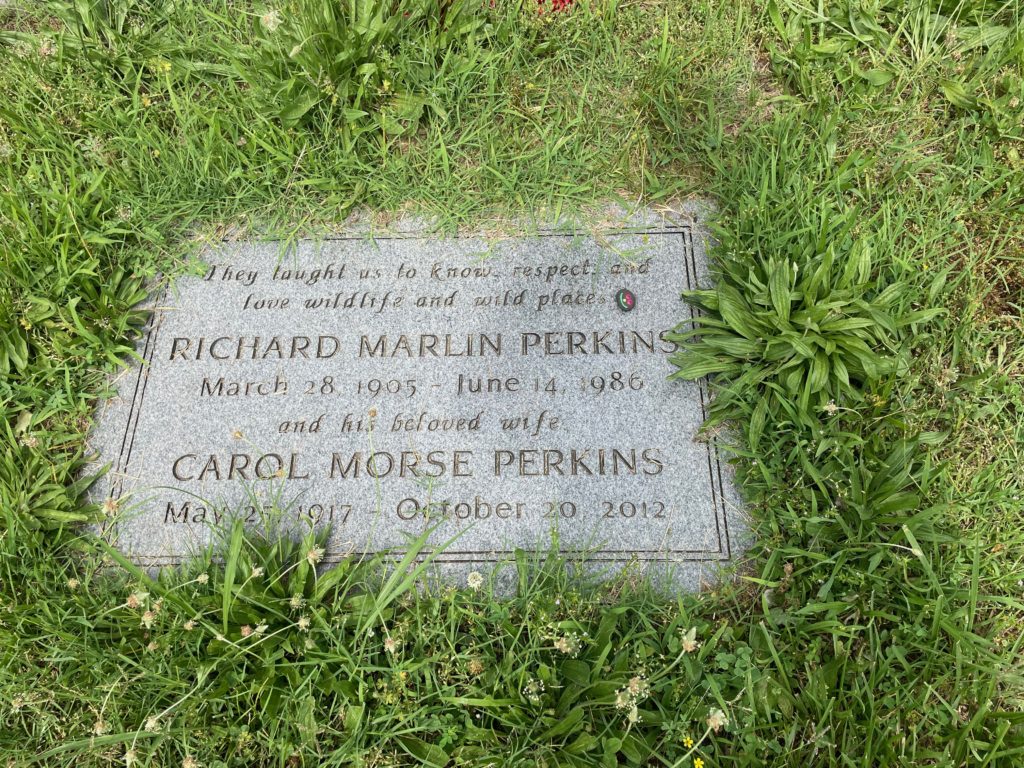Erik Visits an American Grave, Part 955
This is the grave of Marlin Perkins.

Born in 1905 in Carthage, Missouri, Perkins got interested in animals as a young child. He nearly died of pneumonia at the age of 7, but managed to hang on. However, his mother died of it. His father could not handle raising his children alone. Perkins’ older brothers were sent to military school, but he was too young so he spent several years on his aunt’s farm in Kansas before beginning at military school in 1919, where he got in trouble for keeping pet snakes he found. He went to the University of Missouri but dropped out pretty quickly, taking a job in the St. Louis Zoo as a laborer. But his passion for animals soon got the notice of his bosses. In 1928, only 23 years old, he was named reptile curator there. Soon the zoo in Buffalo came calling and by 1938, he was the zoo’s director. In 1944, he moved to Chicago to head the Lincoln Park Zoo and stayed there for 16 years before going home to St. Louis to direct the zoo there. He worked in St. Louis for 10 years and then retired from the zookeeping side of his career in 1970.
Through these years, Perkins both became an internationally respected figure in the zoology world and someone who sought to spread the love of animals through the new media of television. He became the kind of guy who brought great publicity by accompanying expeditions, such as Sir Edmund Hillary’s ridiculous 1960 expedition to search for the yeti. Perkins’ first TV show was called Zoo Parade and was based out of Chicago, when he directed the zoo there. It did quite well, despite Perkins getting bit by a timber rattler while preparing for an episode. That show ran from 1952 until 1957 and was sponsored by the insurance company Mutual of Omaha. In 1962, Perkins and that company got together to work on a new, bigger show. Wild Kingdom (which mentioned the sponsor so often that I basically remember as Mutual of Omaha’s Wild Kingdom, which has to be one of the great marketing sponsorships of all time) ran from 1963 to 1971 with Perkins as the host. It was also a national show, appearing on NBC. It won many Emmy Awards and other awards over the years. While the show basically ended in 1971, there were a few new episodes produced here and there until 1987. On the show, Perkins stayed behind the scenes. It was Jim Fowler who worked with the animals, which were often dangerous. But as the timber rattler and many other incidents he had with snakes demonstrates, that wasn’t out of fear of the animals, though Johnny Carson frequently joked about this when would have them on the show. In fact, he was one of the only humans known to have survived the bite of a West African Gaboon viper.
It’s hard to overstate the importance of Perkins for young people of my age. I was a kid when cable hit and I remember the pre-cable world. I’ve always thought wildlife was super cool and have been lucky enough to see more than my share of cool animals over the years. Some of that was most certainly watching Perkins, even if he was just the older man in the studio with the soothing Midwestern voice. I knew nothing about the man until writing this post, other than of course his show. I feel that my relationship to this show is probably pretty similar to many people who watched it fairly religiously. Moreover, Wild Kingdom deserves a ton of credit for environmental education in the United States. This was the first time most Americans had any exposure to watching animals in the natural habitat on film. Its trips to Africa especially were truly pioneering.
Perkins had cancer late in life. This forced him to retire from television in 1985. He died in 1986, at the age of 81.
Let’s watch a little Wild Kingdom:
Marlin Perkins is buried in Park Cemetery, Carthage, Missouri.
If you would like this series to visit other zoologists or animal biologists, you can donate to cover the required expenses here. Dian Fossey is in Karisoke, Rwanda, which I suppose feels like an unlikely trip, not that I wouldn’t do it. Charles Henry Turner is in Chicago and Howard Gloyd is in Baldwin City, Kansas. Previous posts are archived here.


